pak-ex
effective skin cleansing from soot and PAHs
Fire operations, fire training, respirator workshops – in our fire brigades alone there are many activities where skin contamination with carcinogenic PAHs from fire smoke is unavoidable. This applies to many other occupational groups – including chimney sweeps or workers in fire damage restoration, coking plants or foundries.
pak-ex offers optimal cleaning performance and is safe – because pak-ex is soap-free so as not to impair the natural skin barrier.
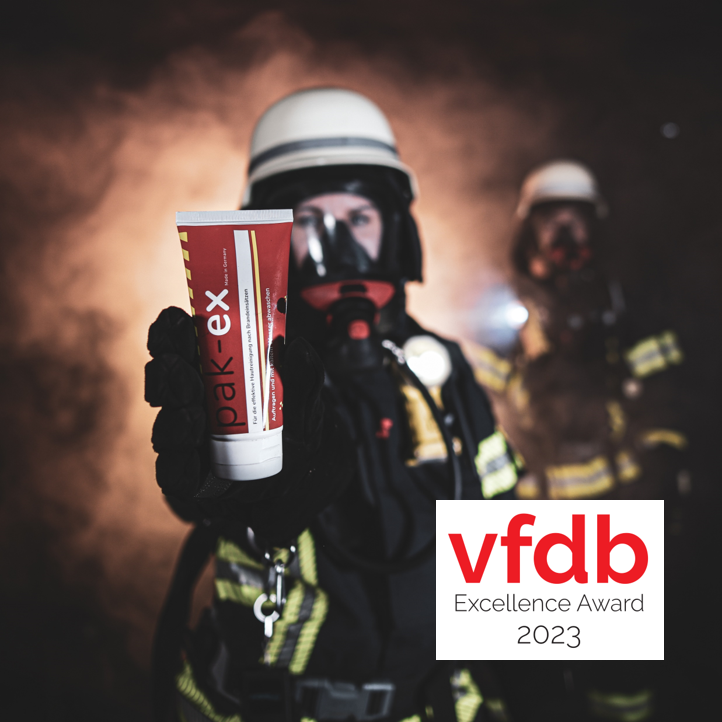
Authorized Distributors - International
Authorized Distributors - Germany
pak-ex on YouTube
Retterpedia publishes short, crisp and mission-relevant videos from the areas of fire and rescue services. In the latest video, our managing director Jonas Schubert is interviewed as an expert on the subject of skin cleansing after firefighting and introduces pak-ex.
+++ Study confirms: Soap and cleaning cloths do not serve their purpose! +++
In a new study, a team of researchers from Canada examined how good or bad soap or cleaning cloths (“wipes”) are for firefighters after firefighting.
The results are alarming: Only 23% of the carcinogenic PAH could be removed with “wipes”. Less than half of the contamination could also be removed with soap – at least slightly more than with the wipes advertised for this purpose.
The results confirm our measurements and show how important technically appropriate skin cleansing is when dealing with hazardous substances.
About the study: Keir JLA et al. J Occup Environ Hyg. 2023 Jan 23:1-11. doi: 10.1080/15459624.2022.2150768. https://pubmed.ncbi.nlm.nih.gov/36469739/

Fire operations - Real fire training - Decontamination Workshops

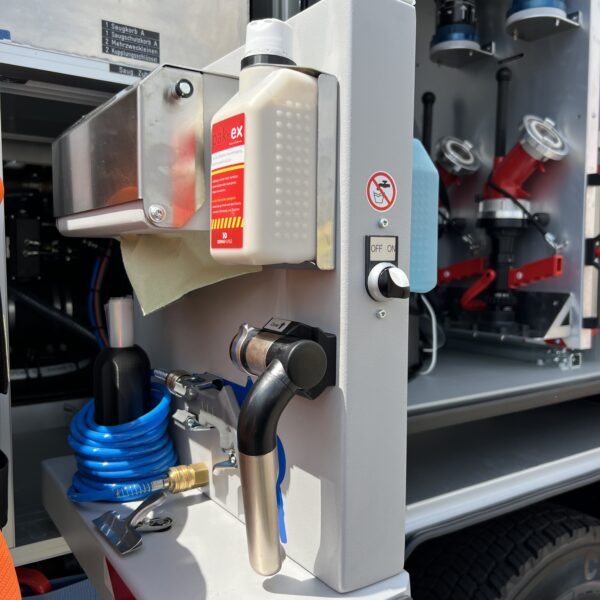
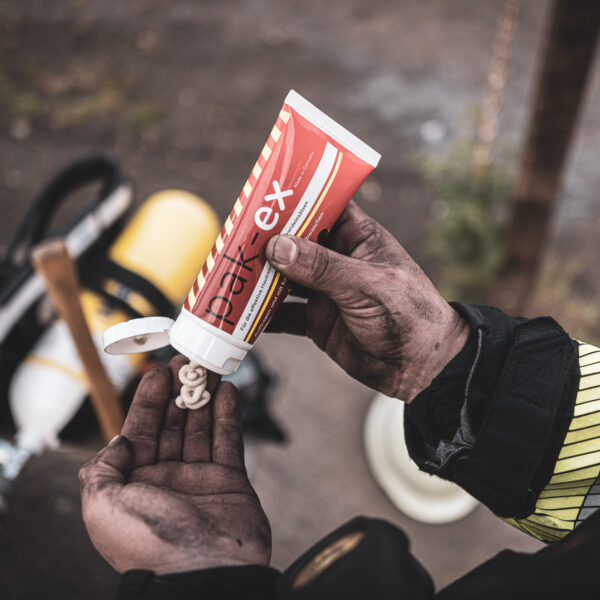
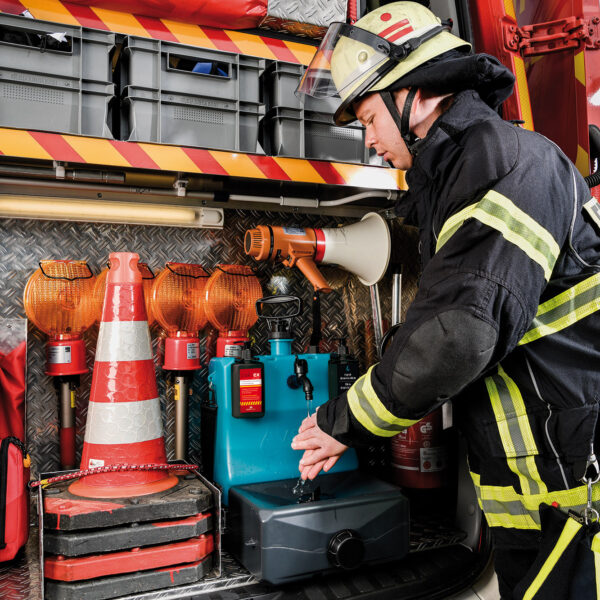
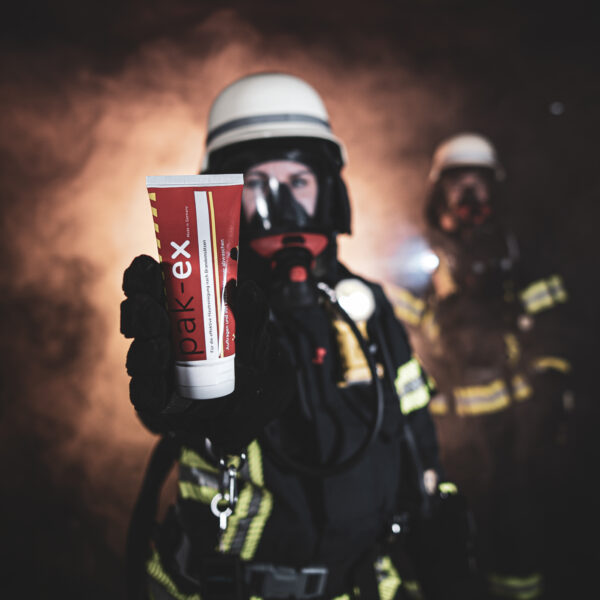
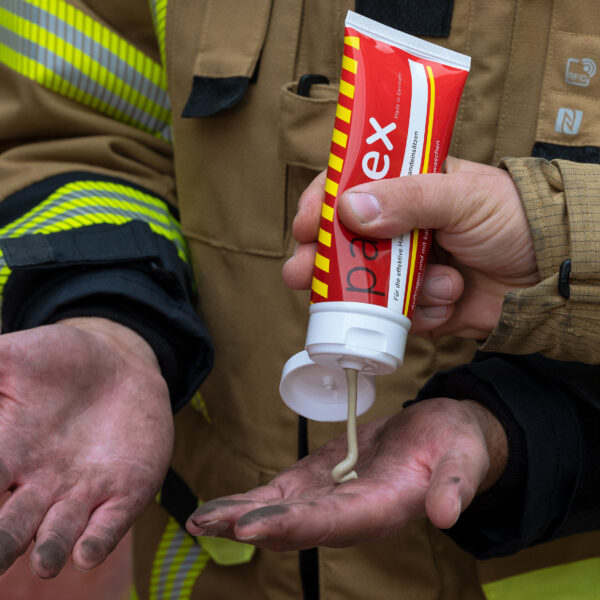
It is important not only for firefighters but for everyone involved in the firefighting operation to thoroughly clean themselves of PAHs after use to avoid contamination from clouds of fire smoke or contact with contaminated equipment such as hoses. The same applies, of course, to training scenarios in real fire training.
In decontamination workshops, people regularly come into contact with contaminated equipment and should pay particular attention to effective skin cleansing before leaving the premises for breaks and end of duty to avoid contamination carry-over.
Skin cleansing from PAHs - what to look out for?
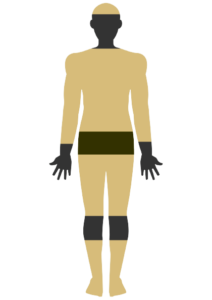
For thorough cleaning after fire operations, particular attention should be paid to the transitions of the protective clothing: Hands and wrists, face and neck, hip area on the transition between jacket and pants, as well as below the knees (the transition between boots and pants).
Cold water should always be used when cleaning the skin of hazardous substances. Water that is too warm impairs the protective barrier of the skin, as do the wrong skin cleansing products. However, it does not have to be ice-cold water. As a guide: maximum 32°C water temperature.

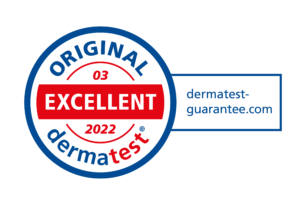
Skin-compatible, pH skin-neutral, for daily use - confirmed by DermaTest.
Tube or Dispenser?
For fixed hygiene stations (e.g. sinks, showers, hygiene boards) we recommend our 500 ml dispenser inserts, which can be used in all common EURO pump dispenser systems.
pak-ex as a tube with a lid is available in two different versions
Sizes (50 ml / 200 ml) available and so flexible and mobile
usable.
The 250 ml pump dispenser can be used free-standing at individual wash stations – and it is compatible for attachment to the Lavese® mobile sink.
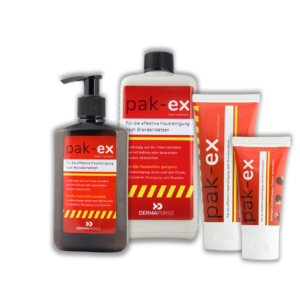
Frequently Asked Questions (FAQ)
1) With soap or wipes, the majority of the carcinogenic substances PAHs remain on the skin.
2) Incorrect cleaning agents such as soap or wipes can even lead to an increased absorption of the hazardous substances.
3) PAHs are carcinogenic and skin-resorptive substances, so they are absorbed through the skin. Therefore, it is crucial to clean the skin as effectively as possible – and to make sure that the natural protective barrier of the skin is not further impaired in order to avoid the “wash-in effect”.
4) Unlike soap or wipes, pak-ex was specifically developed for effective skin cleansing of PAHs, and therefore offers the greatest possible cleansing performance without compromising the skin barrier.
Yes, pak-ex is already in use in some other areas. PAHs are also a problem, for example, for chimney sweeps, in fire damage restoration, in coking plants or foundries. Talk to your specialist dealer or contact us directly!
Polycyclic aromatic hydrocarbons (PAHs, or PAK in German) is a term for a large chemical group of substances that has been the focus of scientific and public attention for decades because of their problematic properties for humans and the environment. The carcinogenic PAHs are found in fire smoke – and are therefore a health risk for occupational groups such as firefighters and chimney sweeps.
PAHs can be taken up into the body via the skin – so in case of contamination, two points are important: effective cleaning and maintaining the natural skin barrier. Soaps and soap-containing products impair the skin barrier – and lead to increased absorption of PAHs!
That is why we have developed pak-ex, an effective and safe state-of-the-art product soution.
Our skin protects us from external environmental influences. Factors such as sweat, very warm water or injuries to the skin can already weaken our skin’s protective barrier and lead to increased absorption of hazardous substances on contact.
From scientific studies, however, a number of substances are also known that act as so-called ‘penetration enhancers’ – i.e. substances that cause the natural skin barrier to be overcome.
In medicine, this principle is used to facilitate the absorption of medical agents through the skin.
But in contact with hazardous substances – such as PAHs in fire operations – these penetration enhancers have no place, of course. Therefore, care must be taken when selecting skin cleansing products!
Soap impairs the skin barrier, many people know that. But what else? Since we have already been asked many times, we have started to compile a list of scientifically proven penetration enhancers.
The list is not complete – but it is a start and should help you to make the right choice for skin cleansing after fire operations based on sound scientific findings.
Alcohol denat [1], Aloe Barbadensis extract [10], Caprylic/Capric Triglyceride [8], Cetylpyridiniumchlorid [13], Chamomilla Recutita Extract [9], Citric Acid [6], Cocamidopropyl Betaine [4], Coco Glucoside [3], Disodium Cocoyl glutamate [7], Glycerin [1], Isopropyl Alcohol [1], Lactic Acid [5], Limonene [12], Linalol [12], PEG-40 Hydrogenated Castor Oil [2], PEG-75, Polysorbat 20 [14], Propylene Glycol [1], Sodium Cocyl Glutamate [7], Sodium Lauryl Sulfate (Soap) [13], Vitamin E [11].
List of references [Link]
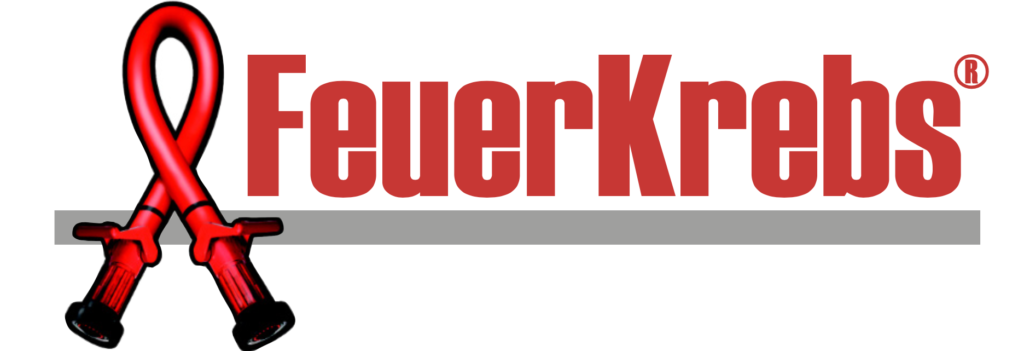
Together for better health and working conditions for our firefighters!
We support FeuerKrebs® – the non-profit society for the promotion and sustainable improvement of health and working conditions for our firefighters.
Dedicated for a reason
Jonas Schubert is the managing director of our DermaPurge GmbH, has a doctorate in chemistry – and has already been active in the fire brigade for 22 years. He is a respirator wearer, group leader and, during his chemistry studies in Bayreuth, was a specialist NBC advisor in the hazardous materials fire brigade.
During his research work at the Leibniz Institute for Polymer Research, he developed the skin cleansing product nano-ex together with his colleague Max Schnepf. With personal motivation and accumulated know-how, the team focused their research and development work on a skin cleansing product for fire brigades to effectively wash PAHs from the skin without impairing the natural skin barrier.

Dr. Jonas Schubert
schubert[at]dermapurge.com
+49 351 4658 700
[1] Williams AC, Barry BW. Penetration enhancers. Advanced Drug Delivery Reviews, Volume 56, Issue 5, 2004, Pages 603-618.
[2] Burnett CL, Heldreth B, Bergfeld WF, et al. Safety Assessment of PEGylated Oils as Used in Cosmetics. International Journal of Toxicology. 2014;33(4_suppl):13S-39S. doi:10.1177/1091581814546337
[3] ElMeshad, AN, Tadros MI. Transdermal Delivery of an Anti-Cancer Drug via W/O Emulsions Based on Alkyl Polyglycosides and Lecithin: Design, Characterization, and In Vivo Evaluation of the Possible Irritation Potential in Rats. AAPS PharmSciTech 12, 1–9 (2011). https://doi.org/10.1208/s12249-010-9557-y
[4] Pandey A, Mittal A, Chauhan N, Alam S (2014) Role of Surfactants as Penetration Enhancer in Transdermal Drug Delivery System. J Mol Pharm Org Process Res 2:113. doi: 10.4172/2329-9053.1000113
[5] Copoví A, Díez-Sales O, Herráez-Domínguez J.V., Herráez-Domínguez M. Enhancing effect of alpha-hydroxyacids on “in vitro” permeation across the human skin of compounds with different lipophilicity, International Journal of Pharmaceutics, Volume 314, Issue 1, 2006, Pages 31-36, ISSN 0378-5173, https://doi.org/10.1016/j.ijpharm.2006.01.033.
[6] Prasanthi D, Lakshmi PK, “Effect of Chemical Enhancers in Transdermal Permeation of Alfuzosin Hydrochloride”, International Scholarly Research Notices, vol. 2012, Article ID 965280, 8 pages, 2012. https://doi.org/10.5402/2012/965280
[7] Okasaka M, Kubota K, Yamasaki E, Yang J & Takata S (2019) Evaluation of anionic surfactants effects on the skin barrier function based on skin permeability, Pharmaceutical Development and Technology, 24:1, 99-104, DOI: 10.1080/10837450.2018.1425885
[8] Leopold CS, Lippold BC. An Attempt to Clarify the Mechanism of the Penetration Enhancing Effects of Lipophilic Vehicles with Differential Scanning Calorimetry (DSC), Journal of Pharmacy and Pharmacology, Volume 47, Issue 4, April 1995, Pages 276–281, https://doi.org/10.1111/j.2042-7158.1995.tb05795.x
[9] Johnson W, Boyer I, Bergfeld W, Belsito D, Hill R, Klaassen C, Liebler D, Marks Jr, Shank R, Slaga T, Snyder P, Gill L, Heldreth B (2018). Amended Safety Assessment of Chamomilla recutita -Derived Ingredients as Used in Cosmetics. International Journal of Toxicology. 37. 51S-79S. 10.1177/1091581818801814.
[10] Cole L, Heard C. Skin permeation enhancement potential of Aloe Vera and a proposed mechanism of action based upon size exclusion and pull effect, International Journal of Pharmaceutics, Volume 333, Issues 1–2, 2007, Pages 10-16, ISSN 0378-5173, https://doi.org/10.1016/j.ijpharm.2006.09.047.
[11] Jay S. Trivedi, Steven L. Krill, James J. Fort, Vitamin E as a human skin penetration enhancer, European Journal of Pharmaceutical Sciences, Volume 3, Issue 4, 1995, Pages 241-243, ISSN 0928-0987, https://doi.org/10.1016/0928-0987(95)00014-5.
[12] Chen J, Jiang Q-D, Chai Y-P, Zhang H, Peng P, Yang X-X. Natural Terpenes as Penetration Enhancers for Transdermal Drug Delivery. Molecules. 2016; 21(12):1709. https://doi.org/10.3390/molecules21121709
[13] Som I, Bhatia K, M. Status of surfactants as penetration enhancers in transdermal drug delivery. J Pharm Bioall Sci 2012;4:2-9.
[14] Akhtar N, Rehman MU, Khan HMS, Rasool F, Saeed T, G Murtaza G. Penetration Enhancing Effect of Polysorbate 20 and 80 on the In Vitro Percutaneous Absorption of LAscorbic Acid. Tropical Journal of Pharmaceutical Research June 2011; 10 (3): 281-288
Picture Credits: heibergerwork, Career jobs photo created by freepik – www.freepik.com































